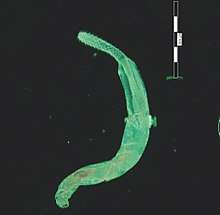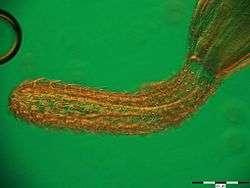Illiosentidae
Illiosentidae is a family of parasitic worms from the order Echinorhynchida.
| Illiosentidae | |
|---|---|
 | |
| Telosentis exiguus | |
| Scientific classification | |
| Kingdom: | Animalia |
| Phylum: | Acanthocephala |
| Class: | Palaeacanthocephala |
| Order: | Echinorhynchida |
| Family: | Illiosentidae Golvan, 1960 |
Species
Illiosentidae contains the following species:[1][lower-alpha 1]
Brentisentis Leotta, Schmidt & Kuntz, 1982
- Brentisentis chongqingensis Wei, 1998[2]
The species name chongqingensis was named after the location where the samples were collected: Chongqing, China.[2]
- Brentisentis uncinus Leotta, Schmidt, Kuntz, 1982[3]
B. uncinus was found infesting the small intestines of the Tank goby (Glossogobius giuris) and Eleotris pisonis near the mouth of Keelung River, Taiwan.[3]
- Brentisentis yangtzensis Yu and Wu, 1989
Dentitruncus Sinzar, 1955
- Dentitruncus truttae Sinzar, 1955
Dollfusentis Golvan, 1969
- Dollfusentis bravoae Salgado-Maldonado, 1976
- Dollfusentis chandleri Golvan, 1969
- Dollfusentis ctenorhynchus (Cable & Linderoth, 1963) Golvan, 1969
- Dollfusentis heteracanthus (Cable and Linderoth, 1963)
- Dollfusentis longispinus (Cable & Linderoth, 1963) Golvan, 1969
- Dollfusentis salgadoi Monks, Aleman-Garcia & Pulido-Flores, 2008
Goacanthus Gupta & Jain, 1980
- Goacanthus panajiensis Gupta and Jain, 1980
Indorhynchus Golvan, 1969
- Indorhynchus indicus (Tripathi, 1959) Golvan, 1969
- Indorhynchus pseudobargi Wang and Wang, 1988
Koronacantha Monks & Ponce de Leon, 1996
- Koronacantha mexicana Monks & Ponce de Leon, 1996
- Koronacantha pectinaria (Van Cleave, 1940) Monks & Pérez-Ponce de León, 1996
Metarhadinorhynchus Yamaguti, 1959
- Metarhadinorhynchus cyprini Yin, 1961
- Metarhadinorhynchus echeneisi Gupta & Sinha, 1991
- Metarhadinorhynchus laterolabracis Yamaguti, 1959
M. laterolabracis is the type species.[4]
- Metarhadinorhynchus thapari Gupta & Gupta, 1975
- Metarhadinorhynchus valiyathurae Nadakal, John et Jacob, 1990[5]
Paradentitruncus Moravec & Sey, 1989
- Paradentitruncus longireceptaculis Moravec & Sey, 1989
Pseudorhadinorhynchus Achmerow & Dombrowskaja-Achmerova, 1941
- Pseudorhadinorhynchus cinereus Gupta & Nagui, 1983
P. cinereus was found infesting Stromateus cinereus in Pakistan.[6]
- Pseudorhadinorhynchus cochinensis Gupta & Nagui, 1983
- Pseudorhadinorhynchus deeghai Saxena, 2003
- Pseudorhadinorhynchus dhari Kumar, 1992
- Pseudorhadinorhynchus dussamicitatum Gupta & Gupta, 1972
- Pseudorhadinorhynchus ernakulensis Gupta & Gupta, 1972
- Pseudorhadinorhynchus guptai Gupta & Sinha, 1993
- Pseudorhadinorhynchus leuciscus (Krotov & Petrochenko, 1956)
- Pseudorhadinorhynchus longicollum Gupta & Naqvi, 1986
- Pseudorhadinorhynchus machidai Kumar, 1992
- Pseudorhadinorhynchus markewitschi Achmerov and Dombrovskaja-Achmerova, 1941
- Pseudorhadinorhynchus mujibi Gupta & Nagui, 1983
P. mujibi was found infesting Stromateus sinensis in Pakistan.[6]
- Pseudorhadinorhynchus nandai Gupta and Sinha, 1993
- Pseudorhadinorhynchus orissai Gupta & Fatma, 1985
- Pseudorhadinorhynchus pseudaspii Achmerov and Dombrovskaja-Achmerova, 1941
- Pseudorhadinorhynchus samegaiensis Nakajima & Egusa, 1975
- Pseudorhadinorhynchus srivastavai Gupta & Fatma, 1985
- Pseudorhadinorhynchus vietnamensis Moravec and Sey, 1989
Tegorhynchus Van Cleve, 1921
- Tegorhynchus africanus (Golvan, 1955)
- Tegorhynchus brevis Van Cleave, 1921
- Tegorhynchus cetratus (Van Cleave, 1945)
- Tegorhynchus edmondsi (Golvan, 1960)
- Tegorhynchus furcatus (Van Cleave & Lincicome, 1939)
- Tegorhynchus holospinus Amin & Sey, 1996
- Tegorhynchus multacanthus (Mamaev, 1970) Amin & Sey, 1996
Telosentis Van Cleve, 1923
Telosentis is a genus of acanthocephalans. The representatives of the genus are distributed in tropical waters of Indian ocean, Pacific coast of Australia and Mediterranean. Consists of four species:[7]
- Telosentis australiensis Edmonds, 1964
- Telosentis exiguus (von Linstow, 1901)
T. exiguus is a widespread intestinal parasitic worm. Its hosts are marine and brackish water fish of the Mediterranean basin. This species is found in the Mediterranean Sea[8] (near the coasts of France and Italy), in the Adriatic Sea (Italy, Montenegro), the Sea of Marmara,[9] the Black Sea and the Sea of Azov (near the coasts of Ukraine). T. exiguus is able to thrive in a variety hosts. It has been found as an intestinal parasite in anchovies, sand-smelts, shads, garfishes, eels, sticklebacks, pipe-fishes, grass gobies, some other gobies, blennies, and wrasses.

T. exiguus' tegument is covered with spines in anterior and posterior parts. Its cerebral ganglion located in central part of the proboscis sac, sometime moved to anterior region. Its proboscis is cylindrical or club-shaped, armed with 12 longitudal rows of hooks of same type; the smaller hooks are in the posterior region of proboscis, larger is in its central part. The roots of the hooks have long forward-facing appendixes.[7]
In the Black Sea the intermediate hosts of this acanthocephalan is the amphipod Apherusa bispinosa,[10] in the coelom of which the cystacanthes are located. Fish are infested by feeding on amphipods infected with larvae.
- Telosentis lutianusi Gupta & Gupta, 1990
- Telosentis mizellei Gupta & Fatma, 1988
- Telosentis molini Van Cleave, 1923
Hosts
Notes
- A binomial authority in parentheses indicates that the species was originally described in a genus other than the present genus.
References
- https://www.itis.gov/servlet/SingleRpt/SingleRpt?search_topic=TSN&search_value=197203#null
- Wei Gang. A new species of Brentisentis from fishes of Chongqing,China(Palaeacanthocephala:Echinorhynchida:Rhadinorhynchidae) Dong wu fen lei xue bao = Acta Zootaxonomica Sinica. 1998 ;23(4):342-345.
- Leotta, S. H., Schmidt, G. D., & Kuntz, R. E. (1982). Brentisentis uncinus gen. et sp. n. and Gorgorhynchus satoi (Morisita 1937) Yamaguti 1963 from Taiwan. The Journal of Parasitology, 134-137.
- Amin, Omar M. (September 19, 2013). "Classification of the Acanthocephala". Folia Parasitologica. 60 (4): 273–305. doi:10.14411/fp.2013.031. PMID 24261131.
- Nadakal, A. M., John, K. O., & Jacob, A. (1990). Metarhadinorhynchus valiyathurae sp. nov., an acanthocephalid worm parasitic in the marine fish, Caranx melampygus (Cuv. & Val.). Zoologischer Anzeiger, 225(5/6), 377-382.
- Kazmi, Q. B., & Naushaba, R. (2013). Checklist of marine worms reported from Pakistani marine waters. Pakistan Journal of Nematology, 31(2), 187-280.
- Kvach Y., Sasal P. (2010) Telosentis exiguus (von Linstow, 1901) (Palaeacanthocephala: Illiosentidae), a generalist parasite of fishes in the Mediterranean basin. Systematic Parasitology, 76(1): 9-18.
- Golvan Y.J. (1969) Systématique des acanthocéphales (Acanthocephala Rudolphi 1801). Première partie. L’ordre de Palaeacanthocephala Meyer 1931. Premier fascicule. La superfamille de Echinorhynchoidea (Cobbold 1876) Golvan et Houin 1963. Mémoires du Muséum National d’Histoire Naturelle (Série A), 57, 1–373.
- Oğuz M.C. (1991) Ekınlı Lagnünüde yakalanan dere pısısı baliklari (Pleuronectus flesus luscus L. 1758) üzerıne parasıtolojık bır araştirma. Turkish Journal of Zoology, 15: 150–163.
- Belofastova I.P., Grintsov V.A. (2003) On the Find of Acantellae of the Acanthocephalan Telosentis exiguus in Apherusa bispinosa (Amphipoda, Calliopiidae) in the Black Sea. Vestnik Zoologii, 37(4): 57–59. (in Russian)